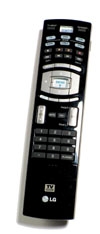LG 50-inch Plasma HDTV with Hard-disk Recorder Page 2
| in the lab |
| Color temperature (Warm color temperature and Movie mode before/after calibration) Low window (20-IRE): 6,471/6,470 K High window (80-IRE): 8,035/6,562 K Brightness (100-IRE window before/after calibration): 63.3/35.2 ftL Before calibration, the LG 50PY2DR exhibited a relatively blue color temperature in its Warm setting, especially in brighter areas. Afterward, its color temperature was much improved, although there was still a significant shift toward green in the middle range of the grayscale. Grayscale tracking, therefore, was below average, varying by an average of 334 K from the standard of 6,500 K despite excellent results at the top and bottom ends of the scale, so observant watchers may notice a slight green tinge in mid-bright areas of the image. (Calibration needs to be performed by a qualified technician, so discuss it with your dealer before purchase, or call the Imaging Science Foundation at 561-997-9073.) Color decoding was very good for standard- and high-def inputs, showing a 5% red push and no error in green. Edge enhancement was negligible with sharpness set properly. As expected for a plasma TV, geometry and picture uniformity were excellent. Black-level retention was below-average for a plasma - the brightness of black varied noticeably on the PLUGE pattern from a Sencore signal generator. Overscan averaged about 5% to either side and 3% along the top and bottom. Minor dithering was visible below 20 IRE as crawling motes of color in the darkest areas. This is a common issue in plasma TVs. - D.K. |
The LG came into its own when the movie brightened up, delivering punchy, well-saturated greens in the forest around Elektra's rental house and vibrant reds, yellows, and oranges in the fruit she obsessively arranges on the countertop. The skin tones of her face in the outdoor light showed well-balanced color. Details in the images were crisp, and aside from the issues with darker areas, I'd rate the LG relatively high on the DVD picture-quality scale.
HDTV, naturally, looked even better. The LG exhibited every bit of ultrarealistic, three-dimensional detail when I tuned into an HDNet presentation of a classical concert. I could count the gray hairs on the cellist's head, but when I paused the image I noticed that a couple of hairs were very slightly flickering. I checked my satellite box and, sure enough, it was set to 1080i-format output. Switching it to 720p eliminated the flicker. Unfortunately for CableCARD users, most HDTV channels use the 1080i format, and CableCARDs don't give you the same option for selecting your output format.
RECORDING FEATURES Of course, what's really special about this TV is its built-in hard drive, which enables the LG to mimic much of the functionality of cable boxes with built-in HDRs - but without the box or its monthly rental fees (although a CableCARD still merits a smaller monthly charge). LG integrated the HDR well into the television, although it's missing some of the capabilities of many late-model cable HDR boxes.
The 160-gigabyte (GB) recorder can store up to 14 hours of HDTV and 62 hours of standard TV at the highest quality - both capacities are less than you'll find in most high-def HDRs. I was able to schedule recordings via the TV Guide On Screen interface and record, pause, reverse, and fast-forward TV from any composite/S-video or RF input (including both the analog and digital/HD tuner and cable inputs). Recording quality in HD looked every bit as good as the original, as did standard-def recordings in their highest-quality mode.

That's all well and good, but the LG set's HDR suffers from one major limitation: it can only record one program at a time. It's not really LG's fault: multistream CableCARDs that enable two-tuner recording are not yet available. With the LG you can watch a second, nondigital program while you're recording something else, but you can't pause or record it.
Managing my recorded shows on the LG was a pleasure. The list is well-organized, and LG included a few options here that I've never seen on a HDR, such as the ability to retitle programs, to create "folders" to store shows (one for each family member, for example), and to generate thumbnails that show a scene from each recorded program. There are also some great batch-organization options that let you move or delete multiple shows at once. The hard disk can store and play digital photos and even music files, both of which I painlessly loaded from a pair of versatile flash-memory card slots on the TV's side.
BOTTOM LINE The LG 50PY2DR's main appeal will be to people looking to get maximum functionality out of a minimum of boxes. Though the HDR/TV Guide features work well overall, the lack of two-tuner recording may be a serious negative for some people. But if you can get over that, this innovative plasma does many things right and combines a host of products into one wall-hangable unit. Deep-pocketed, box-averse shoppers will find a lot to like.













































